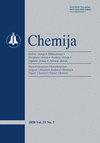高饱和醋酸浴电沉积氧化钼基涂层的XPS研究
IF 0.4
4区 化学
Q4 CHEMISTRY, MULTIDISCIPLINARY
引用次数: 13
摘要
5物理科学与技术中心,3 Saulïtekio Avenue,10257维尔纽斯,立陶宛已经研究了使用高饱和乙酸盐浴电沉积含有Mo氧化物的混合相材料的可能性。XRD表征表明,沉积的涂层是无定形的,并且仅由MoO2和MoO3相组成,没有痕量的金属Mo相。这一说法得到了XPS测量的支持,XPS测量揭示了电沉积中存在三种不同的钼氧化态:Mo4+、Mo5+和Mo6+。研究发现,Mo6+状态占总贡献的41%,而Mo5+和Mo4+分别占28%和31%。沉积物在高达800°C的温度下保持无定形结构;而钼在该温度下主要被氧化成Mo6+态(91%)。这些结果与SEM和EDS的结果相结合,表明与金属Mo相的沉积不同,浓乙酸盐浴可主要用于形成混合价氧化钼膜。本文章由计算机程序翻译,如有差异,请以英文原文为准。
XPS studies on the Mo oxide-based coatings electrodeposited from highly saturated acetate bath
5 Center for Physical Sciences and Technology, 3 Saulėtekio Avenue, 10257 Vilnius, Lithuania The possibility to use highly saturated acetate bath to electrodeposit the mixed-phase materials containing Mo oxides has been investigated. The XRD characterization revealed that the as-deposited coatings are amorphous and consist only of MoO2 and MoO3 phases without traces of metallic Mo phase. This statement has been supported by XPS measurements, which reveal the presence of three different molybdenum oxidations states in electrodeposits: Mo4+, Mo5+ and Mo6+. It was found that the Mo6+ state prevails with 41% of total contribution, whilst Mo5+ and Mo4+ contribute to 28 and 31%, respectively. The deposits retain an amorphous structure up to 800°C; while molybdenum at this temperature is predominantly oxidized to the Mo6+ state (91%). These results, coupled to those of SEM and EDS, revealed that concentrated acetate bath could be used mainly for the formation of the mixed valence molybdenum oxide film unlike to the deposition of the metallic Mo phase.
求助全文
通过发布文献求助,成功后即可免费获取论文全文。
去求助
来源期刊

Chemija
化学-化学综合
CiteScore
1.30
自引率
16.70%
发文量
14
审稿时长
>12 weeks
期刊介绍:
Chemija publishes original research articles and reviews from all branches of modern chemistry, including physical, inorganic, analytical, organic, polymer chemistry, electrochemistry, and multidisciplinary approaches.
 求助内容:
求助内容: 应助结果提醒方式:
应助结果提醒方式:


